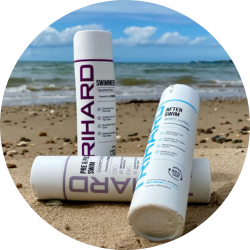How To Put On A Wetsuit More Easily
- 11 Feb 2022

Putting on a wetsuit can be a challenging task for a multitude of reasons, and can be the most exhausting part of the dive of open water swimming. But, squeezing into a wetsuit doesn’t have to be so difficult. Here are some hints and tips for putting one on more easily.
Keep in mind, some wetsuits are simply too tight. If it restricts breathing or blood flow, squeezing around the neck, the wetsuit is too small. Another indication can be if the wetsuit is stretched tightly that the material leaves a hollow at the small of your back or stretches thin in places, this means that the wetsuit is too small. Over-stretched material will not keep you warm as it would if it is a properly fitting and snug wetsuit. This is because a stretched suit will allow water to circulate inside of your wetsuit, whereas a fitting wetsuit will keep you warm by stopping water from circulating inside the suit.

7 tips for squeezing into a tight wetsuit
- The plastic bag trick - place a plastic shopping bag around your foot before sliding into your wetsuit. Once your foot is through the wetsuit leg, remove the bag and repeat the process with your other foot, and then take it to the next level and place it around each hand. The plastic helps the neoprene glide over your skin, without it getting stuck.
- Blow into the wetsuit - this trick requires a helpful friend. Once your hand is through the wetsuit sleeve, have your dive buddy lift the edge of the wrist seal and blow a bubble of air into the suit to help it stretch and slide into the right place.
- Start with the wetsuit inside out - turn the offending wetsuit completely inside out and put one foot through the ankle of the reversed suit. Roll the suit up your leg slowly and repeat with the other leg, the torse, and finally the arms.
- If you can, get into the water with the wetsuit and put it on in the water. Whenever the suit sticks, pull the fabric away from your body to allow water to flow into the suit and break the seal between your body and the suit.
- A dive skin can be worn underneath a wetsuit. Thin lycra dive skins cover a diver from the ankle to wrist to provide protection from wildlife. When under a wetsuit, dive skins help you to put on and remove the suit by preventing the suit from sticking to your skin.
- Use a water-based lubricant - they can help a dive to put on a wetsuit more easily. The diver spreads a small amount of lubricant on his wrists and ankles to help them slide through the tightest parts of the wetsuit.
- Having zippers installed into a suit's ankles and wrist makes putting on a suit much easier.

There are methods you should avoid to try and get a wetsuit on. Using soap, detergents, shampoo, or conditioner as lubricant can affect the suit's neoprene and may irritate or dry out your skin. Biodegradable solutions should not be used with a wetsuit as some of the liquid will also leak from the wetsuit into the water. Even biodegradable versions of detergents and soaps can leave thin residue and can make the neoprene become stiff and begin to crack.
Oil-based products can also damage neoprene, such as petroleum jelly or oil-based lubricants. Don’t use oil, grease, or any oil-based lubricants to aid sliding on a wetsuit.

So, sometimes wetsuits can be a challenge to get on. These tips should help you to get a wetsuit on with more ease and avoid the hassle! Take a look at our Skin Slick Anti-Chafe Skin Lubricant 1.5 Oz which is safe with lycra, neoprene, and wetsuits.
https://www.proswimwear.co.uk//skin-slick-anti-chafe-skin-lubricant-1-5-oz.html



























































































Validate your login